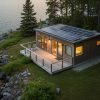The Future of Construction in Canada: How Net Zero is Changing the Game
What is Net Zero and Why Does it Matter?
Imagine a home that powers itself. It doesn’t rely on the grid, doesn’t emit carbon into the atmosphere, and eliminates skyrocketing energy bills. This is Net Zero—a concept where a building produces as much energy as it consumes while maintaining maximum comfort.
The world is evolving, and so is construction. Why is Net Zero the future? Because it’s cost-effective, sustainable, and will soon be the new industry standard.
The Origins of the Net Zero Concept
The idea of Net Zero has been around for decades. Back in the 1970s, experts began exploring ways to make homes more energy-efficient through insulation and smart design. By the 1990s, the first serious Net Zero projects were underway, and in the 2000s, the US, Canada, and Europe started implementing Net Zero Energy Building (NZEB) standards. Today, these buildings are no longer theoretical—they are a reality.
- 1970s: Early experiments with passive houses (Passivhaus).
- 1990s: Advances in solar and wind energy technologies.
- 2000s: The first fully self-sufficient energy homes emerge.
- 2015: The Paris Agreement sets a goal for Net Zero Carbon by 2050.
- 2020s: Canada, Europe, and the US move towards mandatory Net Zero standards.
Net Zero in Canada: Policies and Future Requirements
The Canadian government understands that clean energy is not just a trend but a necessity. That’s why there is a clear roadmap to transition all buildings to Net Zero.
Federal Initiatives
- By 2030: All new homes in Canada must meet Net Zero Energy Ready (NZER) standards.
- By 2050: The entire construction sector must be carbon-neutral.
- Government grants and subsidies: Financial support for homeowners transitioning to Net Zero.
Regional Regulations
- British Columbia: The most progressive province, aiming for 100% Net Zero Ready buildings by 2032.
- Ontario: Toronto mandates all new buildings to be Net Zero Ready by 2028.
- Alberta: Government-backed programs for solar panel installations and energy-efficient upgrades.
What is Net Zero Energy Ready (NZER)?
Net Zero Energy Ready (NZER) refers to homes that are designed and built to be Net Zero in the future—they just need renewable energy systems like solar panels to complete the transition.
How is this achieved?
- ✅ Superior insulation – High-performance walls, roofs, and windows keep heat inside.
- ✅ Airtight construction – Eliminates heat loss and drafts.
- ✅ Smart heating and cooling – Heat pumps and energy recovery ventilation (HRV).
- ✅ Solar-ready infrastructure – Homes are pre-wired for solar panel installation.
- ✅ Low energy consumption – LED lighting, energy-efficient appliances, and automation.
Net Zero Success Stories in Canada
Here are some outstanding examples of Net Zero buildings already operating in Canada:
The Mosaic Centre (Edmonton, Alberta) – The first Net Zero commercial office in Canada, powered by solar energy and geothermal heating.
Evolv1 (Waterloo, Ontario) – A commercial building that produces 107% more energy than it consumes.
Discovery Ridge Net Zero Community (BC) – The first residential community built entirely to Net Zero standards.
The Future of the Construction Industry
By 2030, most homes in Canada will be built to Net Zero Energy Ready standards, meaning:
- Lower energy bills and reduced heating costs.
- Sustainability and a significant reduction in CO₂ emissions.
- Increased property values for energy-efficient homes.
- Advanced energy storage technologies (batteries, hydrogen fuel cells).
Conclusion
Net Zero is no longer a distant concept—it is happening right now. Construction is becoming smarter, greener, and more cost-effective. At VIGO HOUSE, we design homes that meet the standards of the future, ensuring they are both comfortable and energy-efficient.
Want to build a home of the future today? Contact us—we’ll help make your vision a reality!










